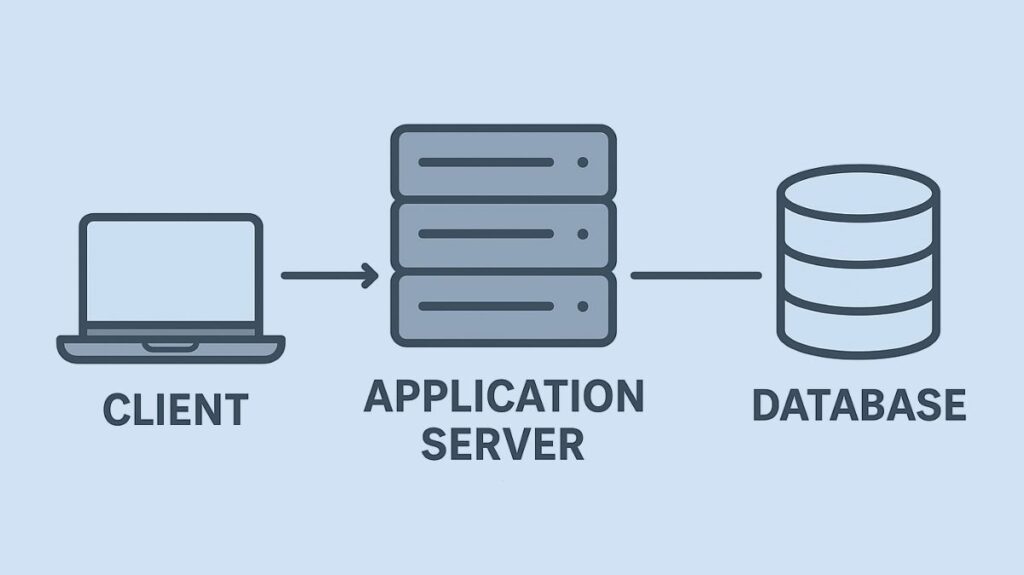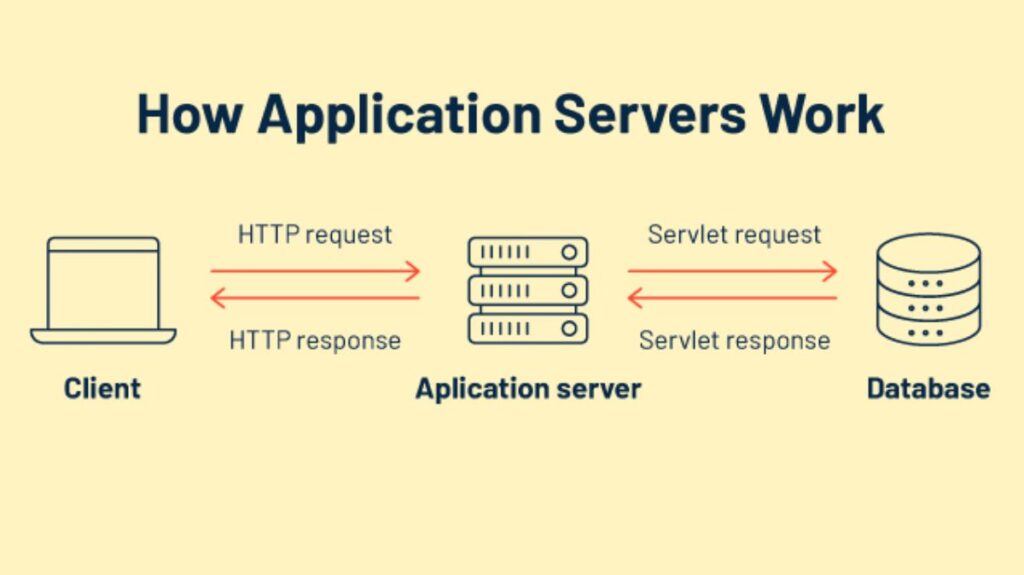In this article, we learn about What is Application server, Core Function and Role, Key Features, How Application Server Works, Examples of Application Servers, Advantages and Disadvantages of Application Servers, Application servers Models, and Monitoring Application Servers
What is Application server
A server type called an application server, also known as a “app server” or “web application server,” is made especially to host, operate, and administer business applications. It serves as a software framework that gives these apps a runtime environment and is regarded as an essential tool for contemporary businesses.
To put it briefly, an application server facilitates communication between the front-end (client) and back-end (database), controls business logic, and distributes programs to users.

Core Function and Role
The primary purpose of an application server is to:
- Process intricate business logic and carry out application logic.
- Respond to user requests by managing the creation of dynamic material, such as interactive websites.
- Act as a “middle layer” or middleware between client requests and backend systems, such as messaging apps and databases.
- Using a communication protocol, present a business application.
The application server is located in the Logic Tier (Tier 2) of a conventional three-tier application architecture, which is situated between the Presentation Tier (client/user interface) and the Data Tier (databases/backend systems). By often operating various layers on different servers, this architecture seeks to avoid single points of failure. An application server framework is designed to free up developers to concentrate on the business logic.
You can also read Purpose of Database Server and How a Database Server Works
Key Features and Capabilities
Application servers offer a comprehensive environment with various features to simplify and improve processes:
- Execution of Business Logic It offers a runtime environment in which business logic can be processed by application code. Applications use this logic to perform crucial tasks like transactions and business rule-based computations.
- Generating Dynamic Content It produces dynamic content like real-time updates, customized information, and database results that varies according to user input.
- Services for Middleware It provides necessary services such as security, data access, transaction processing, and state management. Additionally, it facilitates integration and communication between different program components.
- Including It links many program elements to outside resources, like chat apps and databases.
- Performance and Scalability Application servers are made to be very efficient and scalable. To manage several client requests at once and keep performance high, particularly during periods of high traffic, they make use of technologies like multithreading. Adding more server instances allows them to extend programs horizontally.
- Safety They offer security features like device control, data encryption, authorization, and authentication. They aid in preventing malware attacks like SQL injection by blocking direct connections between a website and its database.
- Balance of Loads Numerous application servers can split up requests among several servers or nodes, which guarantees peak performance even when traffic is heavy.
- Management of Transactions They provide connection pooling and guarantee data consistency during activities.
- Support for Multiple Platforms They support languages like Java, ASP,.NET, and PHP and can run apps on a variety of devices and operating systems. They are also frequently language-agnostic.
- Centralized Administration They make configuration, patching, updating, and delivery easier by providing a centralized platform for managing and distributing apps.
- Development and Deployment Made Simpler They reduce development cycles and time-to-market by offering code libraries and built-in services for common tasks.
How Application Server Works

Application servers commonly work in tandem with web servers. The typical workflow is as follows:
- An HTTP request is sent by a client, such as a web browser.
- The request is sent to the web server. The web server sends the requested static content, such as HTML, photos, videos, or files, straight to the client.
- The web server forwards the request to the application server if it calls for complicated processing or dynamic content.
- In order to process the request, the application server runs application code, applies business logic, and communicates with databases and messaging systems, among other resources.
- The dynamic content or response is created by the application server and returned to the web server.
- The client then receives the response from the web server. Application servers handle other communication protocols including RPC (Remote Procedure Calls) and RMI (Remote Method Invocation), even though web servers mostly employ HTTP. The phrase “web application server” was coined, nonetheless, because many contemporary application servers also have web server features and make use of HTTP as their main protocol.
You can also read What Is A FTP Server? TFTP Vs FTP, And Security FTP Server
Examples of Application Servers
There are application servers for a number of systems and languages:
Java-based: JBoss/WildFly, Jetty, JEUS, Apache Tomcat, Oracle GlassFish, and IBM WebSphere. The fundamental functionality and API for these servers, which include EJB, Web (Servlets, JSP), JCA, and JMS containers, are defined by Jakarta EE (previously Java EE).
Microsoft .NET: Internet Information Services (IIS), Windows Server’s.NET Framework technologies, and Microsoft Learn Application Server for Windows. This ecosystem includes components such as Windows Communication Foundation (WCF), Message Queuing, ASP.NET, and COM+.
PHP-based: Although web servers can execute PHP, specialized PHP application servers, such as Zend Server, offer a more reliable environment for sophisticated applications.
Others: Node.js runtimes with frameworks like Express.js (not typical app servers, although they have a comparable function), Tuxedo, ColdFusion, WEBrick (Ruby-based), and Zope (Python-based).
Advantages and Disadvantages of Application Servers
Advantages
Great compatibility: Guarantees that data is compatible and that every client uses the same software version.
More security: Reduces malware assaults by blocking direct database connections.
Better performance: Increases efficiency by optimizing commonly used application features like caching and request/response.
Simpler configuration: Centralization reduces complexity and conserves resources.
Increased scalability and flexibility: Multithreading and a wide range of connection options enable greater scalability.
Shorter development cycles: Provides code libraries and built-in services.
Centralized management: Offers interfaces and capabilities for managing and deploying apps from a single platform.
Disadvantages
Higher costs: Upkeep and installation might be costly.
Potential delays: There may be delays in deployment, particularly when it takes place behind a firewall.
Demanding programming: More programming expertise and knowledge are needed.
Greater resource consumption: Makes use of greater resources than web servers.
Difficult problem solving: Because of centralized dependencies, issues or errors may affect more than one client, making fixes more challenging.
Application servers Models
Deployment Models Application servers can be deployed in various ways:
- On-premises: Conventional physical servers are on-premises.
- Cloud: As cloud services or virtual machines (VMs).
- Infrastructure as a Service (IaaS): Offers virtual machines (VMs); however, it is up to the user to install and modify the apps.
- Platform as a Service (PaaS): Developers can concentrate on application code by using environment as a Service Platform as a Service (PaaS), which provides a prebuilt development environment with virtual machines (VMs) and software development tools.
- Software as a Service (SaaS): The user accesses a ready-to-use program via the internet, while the underlying infrastructure remains hidden.
- Private cloud: A dedicated cloud environment for a single organization.
Monitoring Application Servers
Monitoring application servers is crucial because of their crucial role in web application architecture. Tracking the runtime engine (such as Java or NET), workloads, response times, CPU and memory utilization, and network throughput are all included in this. Monitoring aids in resource allocation, problem solving, and predicting future resource needs. Popular application servers have built-in monitoring features provided by tools such as eG Enterprise.
You can also read Advantages Of A File Server And How Do File Servers Works
